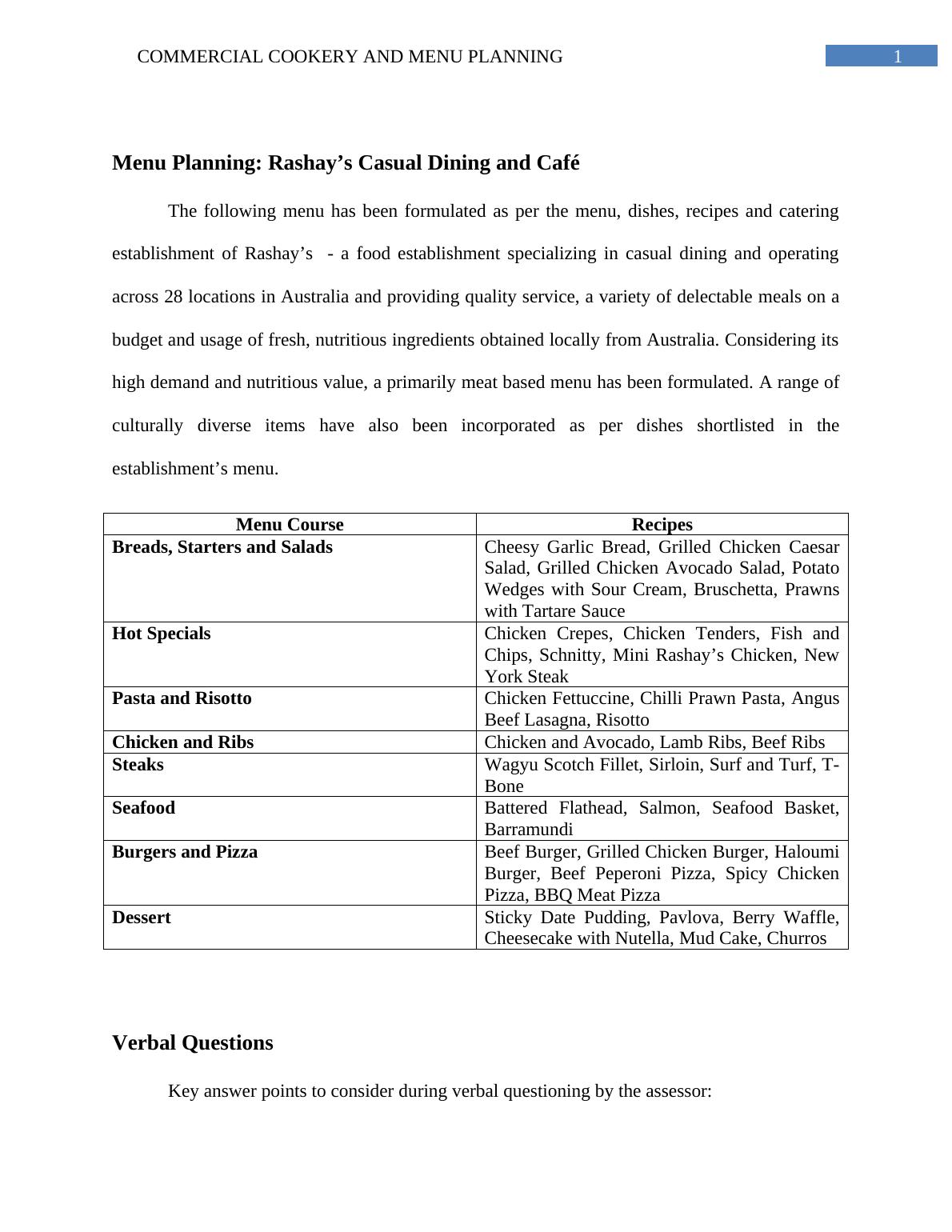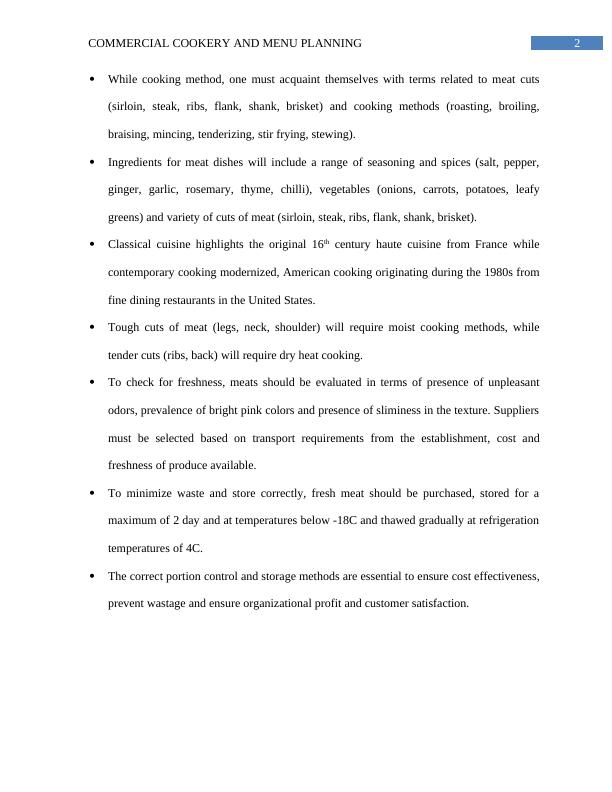Commercial Cookery and Menu Planning
Added on 2022-12-14
7 Pages1380 Words330 Views
Running head: COMMERCIAL COOKERY AND MENU PLANNING
COMMERCIAL COOKERY AND MENU PLANNING
Name of the Student:
Name of the University:
Author note:
COMMERCIAL COOKERY AND MENU PLANNING
Name of the Student:
Name of the University:
Author note:

1COMMERCIAL COOKERY AND MENU PLANNING
Menu Planning: Rashay’s Casual Dining and Café
The following menu has been formulated as per the menu, dishes, recipes and catering
establishment of Rashay’s - a food establishment specializing in casual dining and operating
across 28 locations in Australia and providing quality service, a variety of delectable meals on a
budget and usage of fresh, nutritious ingredients obtained locally from Australia. Considering its
high demand and nutritious value, a primarily meat based menu has been formulated. A range of
culturally diverse items have also been incorporated as per dishes shortlisted in the
establishment’s menu.
Menu Course Recipes
Breads, Starters and Salads Cheesy Garlic Bread, Grilled Chicken Caesar
Salad, Grilled Chicken Avocado Salad, Potato
Wedges with Sour Cream, Bruschetta, Prawns
with Tartare Sauce
Hot Specials Chicken Crepes, Chicken Tenders, Fish and
Chips, Schnitty, Mini Rashay’s Chicken, New
York Steak
Pasta and Risotto Chicken Fettuccine, Chilli Prawn Pasta, Angus
Beef Lasagna, Risotto
Chicken and Ribs Chicken and Avocado, Lamb Ribs, Beef Ribs
Steaks Wagyu Scotch Fillet, Sirloin, Surf and Turf, T-
Bone
Seafood Battered Flathead, Salmon, Seafood Basket,
Barramundi
Burgers and Pizza Beef Burger, Grilled Chicken Burger, Haloumi
Burger, Beef Peperoni Pizza, Spicy Chicken
Pizza, BBQ Meat Pizza
Dessert Sticky Date Pudding, Pavlova, Berry Waffle,
Cheesecake with Nutella, Mud Cake, Churros
Verbal Questions
Key answer points to consider during verbal questioning by the assessor:
Menu Planning: Rashay’s Casual Dining and Café
The following menu has been formulated as per the menu, dishes, recipes and catering
establishment of Rashay’s - a food establishment specializing in casual dining and operating
across 28 locations in Australia and providing quality service, a variety of delectable meals on a
budget and usage of fresh, nutritious ingredients obtained locally from Australia. Considering its
high demand and nutritious value, a primarily meat based menu has been formulated. A range of
culturally diverse items have also been incorporated as per dishes shortlisted in the
establishment’s menu.
Menu Course Recipes
Breads, Starters and Salads Cheesy Garlic Bread, Grilled Chicken Caesar
Salad, Grilled Chicken Avocado Salad, Potato
Wedges with Sour Cream, Bruschetta, Prawns
with Tartare Sauce
Hot Specials Chicken Crepes, Chicken Tenders, Fish and
Chips, Schnitty, Mini Rashay’s Chicken, New
York Steak
Pasta and Risotto Chicken Fettuccine, Chilli Prawn Pasta, Angus
Beef Lasagna, Risotto
Chicken and Ribs Chicken and Avocado, Lamb Ribs, Beef Ribs
Steaks Wagyu Scotch Fillet, Sirloin, Surf and Turf, T-
Bone
Seafood Battered Flathead, Salmon, Seafood Basket,
Barramundi
Burgers and Pizza Beef Burger, Grilled Chicken Burger, Haloumi
Burger, Beef Peperoni Pizza, Spicy Chicken
Pizza, BBQ Meat Pizza
Dessert Sticky Date Pudding, Pavlova, Berry Waffle,
Cheesecake with Nutella, Mud Cake, Churros
Verbal Questions
Key answer points to consider during verbal questioning by the assessor:

2COMMERCIAL COOKERY AND MENU PLANNING
While cooking method, one must acquaint themselves with terms related to meat cuts
(sirloin, steak, ribs, flank, shank, brisket) and cooking methods (roasting, broiling,
braising, mincing, tenderizing, stir frying, stewing).
Ingredients for meat dishes will include a range of seasoning and spices (salt, pepper,
ginger, garlic, rosemary, thyme, chilli), vegetables (onions, carrots, potatoes, leafy
greens) and variety of cuts of meat (sirloin, steak, ribs, flank, shank, brisket).
Classical cuisine highlights the original 16th century haute cuisine from France while
contemporary cooking modernized, American cooking originating during the 1980s from
fine dining restaurants in the United States.
Tough cuts of meat (legs, neck, shoulder) will require moist cooking methods, while
tender cuts (ribs, back) will require dry heat cooking.
To check for freshness, meats should be evaluated in terms of presence of unpleasant
odors, prevalence of bright pink colors and presence of sliminess in the texture. Suppliers
must be selected based on transport requirements from the establishment, cost and
freshness of produce available.
To minimize waste and store correctly, fresh meat should be purchased, stored for a
maximum of 2 day and at temperatures below -18C and thawed gradually at refrigeration
temperatures of 4C.
The correct portion control and storage methods are essential to ensure cost effectiveness,
prevent wastage and ensure organizational profit and customer satisfaction.
While cooking method, one must acquaint themselves with terms related to meat cuts
(sirloin, steak, ribs, flank, shank, brisket) and cooking methods (roasting, broiling,
braising, mincing, tenderizing, stir frying, stewing).
Ingredients for meat dishes will include a range of seasoning and spices (salt, pepper,
ginger, garlic, rosemary, thyme, chilli), vegetables (onions, carrots, potatoes, leafy
greens) and variety of cuts of meat (sirloin, steak, ribs, flank, shank, brisket).
Classical cuisine highlights the original 16th century haute cuisine from France while
contemporary cooking modernized, American cooking originating during the 1980s from
fine dining restaurants in the United States.
Tough cuts of meat (legs, neck, shoulder) will require moist cooking methods, while
tender cuts (ribs, back) will require dry heat cooking.
To check for freshness, meats should be evaluated in terms of presence of unpleasant
odors, prevalence of bright pink colors and presence of sliminess in the texture. Suppliers
must be selected based on transport requirements from the establishment, cost and
freshness of produce available.
To minimize waste and store correctly, fresh meat should be purchased, stored for a
maximum of 2 day and at temperatures below -18C and thawed gradually at refrigeration
temperatures of 4C.
The correct portion control and storage methods are essential to ensure cost effectiveness,
prevent wastage and ensure organizational profit and customer satisfaction.

End of preview
Want to access all the pages? Upload your documents or become a member.
Related Documents
Commercial Cookery Certificate Assignment 2022lg...
|8
|2248
|56
Commercial Cookery Menu: Operations, Assessment, and Successlg...
|18
|2333
|54
